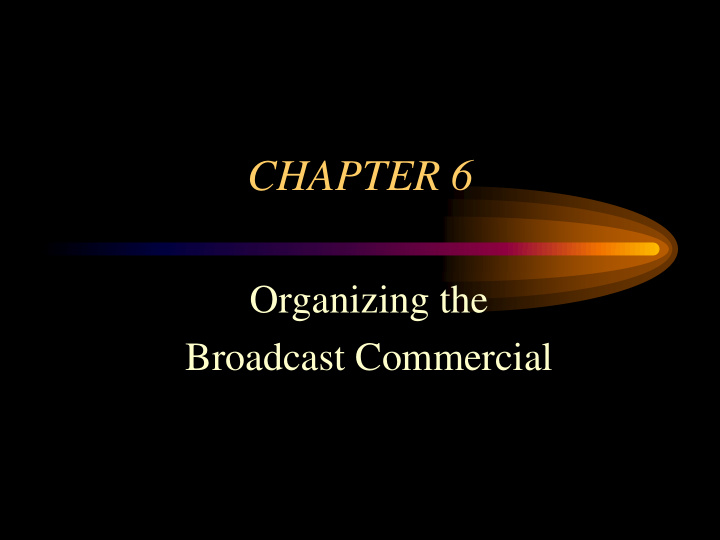



CHAPTER 6 Organizing the Broadcast Commercial
What Makes a GREAT commercial?
AIDA • Attention • Interest • Desire • Action
ATTENTION • grab the listener /viewer • Do it quickly – 3 to 4 seconds • Startling / humorous / important • HOOK
Interest • What gains attention may NOT hold interest • Target audience • Stick with main idea • Benefits • Direct copy to one listener / viewer • Goal of spot / name of product • What is the spot about?
Desire • Desire grows out of benefit • I want one…… WHY? • Understand how target customers – Think – Behave – Make decisions • Match wants/needs w/ product benefits
ACTION • Convince listener/viewer to become customer • Tell them what you expect them to do • Be specific and direct • Stress timeliness • Sponsor name, address, slogan – Clear and direct
SLOGANS and TAGLINES • Branding: How a business wants to be perceived by consumers • Slogan- brief, catchy statement to help with branding. Represents a single product.. • Tagline – represents the business. Often appears with the Logo. Will change frequently.
National Slogans • America runs on ________ • Just Do It! • Umm, Umm, Good! • Nothing runs like a Deere • I’m Lovin’ it
Think you’re smart? • Do the Dew • The Silver Bullet • Have it your way • Snap! Crackle! Pop! • Double your pleasure • Finger lickin’ good
$5.00 QUESTION • Celebrate the moments of your life • ANSWER • General Foods International Coffee
How to make a great slogan • Make it memorable – How quickly is the slogan recognized? – How long will people have to spend thinking about it ? – Include a great selling point • Sell the product and the benefits
Great Slogans • Set your product apart from the rest – What makes it so special – Why is it the best, fastest, etc. – Create a positive and upbeat message • Sell the product and the benefits
Make it have impact
Creating Effective Radio Commercials 1. Make the big idea crystal clear. Concentrate on one main selling point. Radio is a good medium for building brand awareness, but not for making long lists of points (benefits). 2. Mention the advertiser’s name early and often. If the product or company name is tricky, consider spelling it out. 3. Take time to set the scene and establish the premise. A 30-second commercial that nobody remembers is a waste of money. 4. Use familiar sound effects. Ice tinkling in a glass, birds chirping, or a door shutting can create a visual image. Music also works if its meaning is clear. 5. Paint pictures with your words. Use descriptive language to make the ad more memorable.
6. Make every word count. Be conversational. Use pronounceable words and short sentences. 7. Be outrageous. The best comic commercials begin with a totally absurd premise from which all developments follow logically. But, remember, if you can’t write humor really well, go for drama. 8. Ask for the order. Try to get listeners to take action (remember AIDA). 9. Radio is a local medium. Adjust your commercials to the language of your listeners (target market) and the time of day they’ll run. 10. Presentation counts a lot. Even the best scripts look boring on paper. Acting, timing, vocal quirks, and sound effects bring them to life
ASSIGNMENT • IN CLASS #2 Utilizing the following information, write a commercial for Import Motors that incorporates the AIDA concept. :30 Import Motors Started business in 1969 Sells Audi / Porsche / Mercedes Address – 4403 Main Street (across from CVS) Service Dept. noted for high quality work New & Used Cars Available
Recommend
More recommend